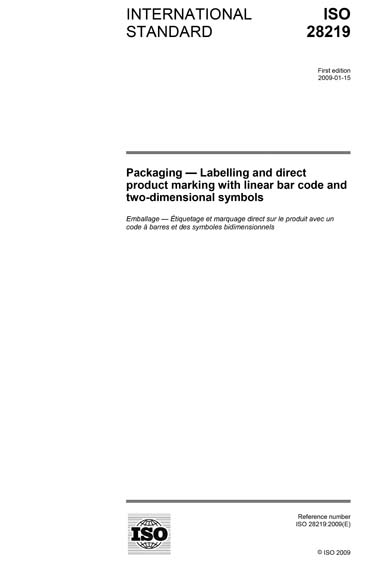Historical
ISO 28219:2009
Packaging - Labelling and direct product marking with linear bar code and two-dimensional symbols
ISO 28219:2009
- defines minimum requirements for identifying items;
- provides guidelines for item marking with machine-readable symbols;
- covers both labels and direct marking of items;
- includes testing procedures for label adhesive characteristics and mark durability;
- provides guidance for the formatting on the label of data presented in linear bar code, two-dimensional symbol or human readable form;
- is intended for applications which include, but are not limited to, support of systems that automate the control of items during the processes of:
- production;
- inventory;
- distribution;
- field service;
- point of sale;
- repair, and
- is intended to include, but it is not limited to, multiple industries including:
- automotive;
- aerospace;
- chemical;
- consumer items;
- electronics;
- health care;
- marine;
- rail;
- telecommunications.
The location and application method of the marking are not defined (these will be reviewed and agreed upon by suppliers and manufacturers and their trading partners before implementing ISO 28219:2009 ).
ISO 28219:2009 does not supersede or replace any applicable safety or regulatory marking or labeling requirements. ISO 28219:2009 is meant to satisfy the minimum item marking requirements of numerous applications and industry groups and as such its applicability is to a wide range of industries, each of which may have specific implementation guidelines for it. ISO 28219:2009 is to be applied in addition to any other mandated labeling direct-marking requirements.
The labeling and direct marking requirement of ISO 28219:2009 and other standards can be combined labeling into one label or marking area or appear as separate labels or marking areas.
ISO 28219:2009 uses the terms “part marking” and “item marking” interchangeably. Unless otherwise stated, this document will use the term “item marking” to describe both the labeling and direct part marking (DPM) of an item, where DPM includes, but is not limited to, altering (e.g. dot peen, laser etch, chemical etch) as well as additive type processes (e.g. ink jet, vacuum deposition).
The purpose of ISO 28219:2009 is to establish the machine-readable (linear, two dimensional, and composite symbols) and human readable content for direct marking and labeling of items, parts, and components.
ISO 28219:2009 provides a means for items, parts and components to be marked, and read in either fixtured or handheld scanning environments at any manufacturer's facility and then read by customers purchasing items for subsequent manufacturing operations or for final end use. Intended applications include, but are not limited to supply chain applications, e.g. inventory, distribution, manufacturing, quality control, acquisition, transportation, supply, repair, and disposal.
Content Provider
International Organization for Standardization [iso]






